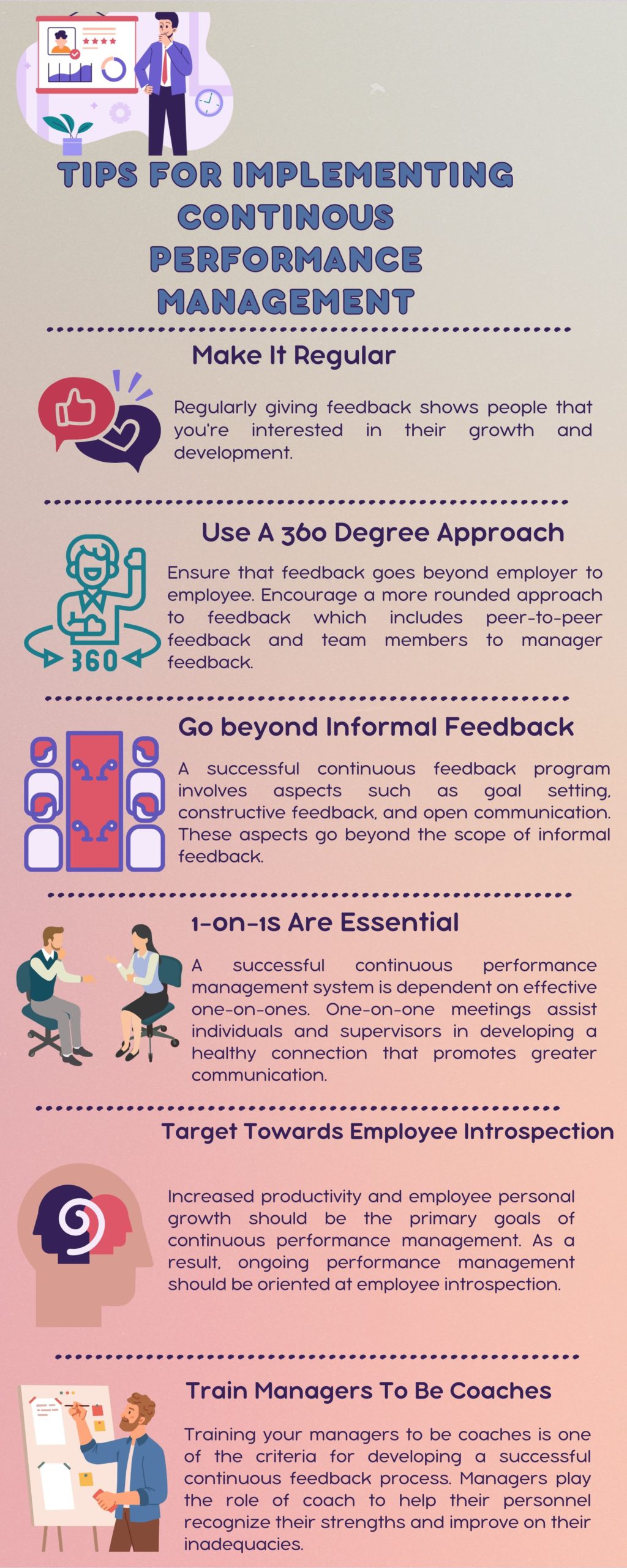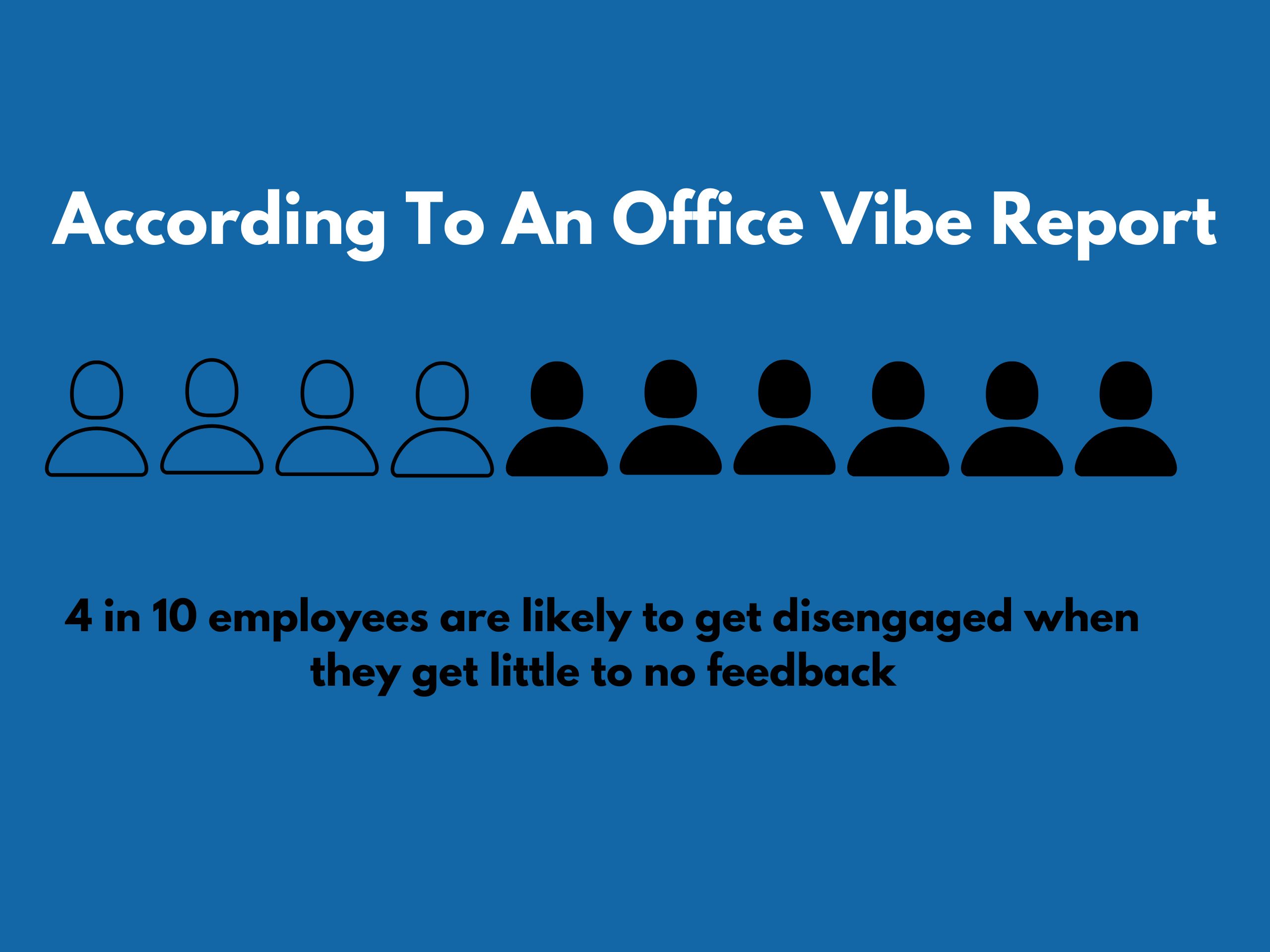A Beginner's Guide To Continuous Feedback Performance Management
Subscribe to the Newsletter
This post is a complete guide to the use of feedback in continuous performance management. In a nutshell, we will discuss continuous feedback and how it relates to performance management.
Continuous performance management is an upgrade from the traditional performance management system that was based on assessing employees based on their annual performance. Essentially, while performance review was based on annual feedback, continuous performance management is based on more frequent feedback, either daily, weekly, or monthly.
According to a report, 95% are managers feel dissatisfied with their traditional performance reviews. In contrast, employees who receive daily feedback from their managers are 3x more engaged than employees who only receive annual feedback. This statistic is a pointer to the impact of continuous feedback on employee engagement.
So, if you want to learn about continuous performance management and its benefits for your organization, you are in the right place.
What is Continuous Feedback?
Continuous feedback is a mechanism employed in an organization’s human capital management, where an employee receives feedback regularly from managers or peers. It is a strategy that enables individuals in an organization to discuss each other’s strengths and weaknesses to promote growth and productivity. Therefore, organizations should make continuous feedback a standard practice.
The continuous feedback process can be as frequent as you like. In-person meetings, phone calls, and surveys can be used to facilitate it. It can occur daily, weekly, or biweekly.

According to a report, teams with managers who received strengths feedback were 12.5% more productive than teams with managers who received no feedback. In the same report, it was reported that 80% of millennials said they prefer on-the-spot recognition over formal reviews.
These statistics are a reflection of the importance of continuous feedback in your performance management. Feedback, whether positive or negative, is expected to improve performance when delivered appropriately. Other statistics from the earlier quoted report show that 92% of respondents in the survey agreed with the statement, “negative feedback, if delivered appropriately, is effective at improving performance.”

Ashley Faus, Content Strategy Lead at Atlassian, shared details of her experiment with continuous feedback. She reported seeking feedback for 30 days from her husband, peers, and even from new team members at work. Her inference after the experiment was that she could organize information much differently and better. She also noted that the experiment helped shape a cycle of appreciation between herself and her husband—and that this contributed to her conscious effort of contributing.
Ashley further stated, “This same reciprocation of pitching in, giving feedback, and recognizing contributions are important at work, too.”
How Does Continuous Performance Management Work?
Here are some of the guidelines for implementing continuous performance management at work.

Make It Regular
Feedback is important but not always necessary for every action or situation. You don’t have to tell people they’re doing a good job every time they open an email or make a phone call. But when positive feedback is often given, negative feedback becomes less of an ordeal.
Regular feedback shows people that you care about their personal growth and development.
360-Degree Feedback
Traditional performance management approaches typically involve only top-down communication. Performance reviews and employee appraisals ideally assume a vertical nature. However, the case is different for continuous performance management.
Continuous performance management involves a 360-degree approach to communication that fosters a positive, healthy work environment. With continuous performance management, feedback transcends communication between the employer and the employee, it also involves peer-to-peer communication. It is encouraged for team members to provide feedback to managers and even suggest improvements. You can also consider giving out surveys to help with this type of feedback.
It Is Beyond Informal Feedback
The concept of continuous feedback revolves around a culture of informal communication; however, it is much more than that. While receiving the casual “Great job!” is great, these informal affirmations are not the end of continuous feedback.
A successful continuous feedback program is built on a solid foundation of goal-setting, constructive feedback, daily praise, and open communication between managers and employees, as well as between peers. Some of these high-level alignments are beyond the scope of informal feedback.
Understanding the company’s long-term strategy can be difficult to get in informal conversations. Hence, review meetings and performance management software can help employees see the big picture and understand how their work fits into the company’s structure.
It should be noted that as unproductive as performance reviews may seem, they still play a critical role in aligning employees with the organization’s objectives and key results (OKRs). Thus, continuous performance management should also be approached from the standpoint of a high-level engagement, with the implementation of a standardized process and the onboarding of performance management tools.
1-on-1s are the Foundation
A successful continuous performance management program is built on the foundation of effective 1-on-1s. One-on-ones help employees and managers build a thriving relationship, which fosters better communication.
Essentially, 1-on-1s are a chance for managers and employees to know each other better. They can also be a chance for managers to keep tabs on their employees’ professional development and gain insight into employees’ thoughts about their daily work.
Results from a survey by Quantum Workplace show that in contrast with 3% of employees who prefer to have annual one-on-ones, 36% of employees prefer to have weekly one-on-ones. The survey showed that 71% of employees who have weekly one-on-ones with their managers are highly engaged, compared to 53% of employees who only have annual one-on-ones with their managers.
The effectiveness of one-on-ones cannot be limited to just in-person communication, as there are performance management software and tools that facilitate continuous feedback. Some of the software include Slack, BambooHR, Lever, and Justworks.
Targeted Towards Introspection
One difference between continuous and traditional performance management methods is their method of approach. While traditional performance reviews are one-sided, manager-driven discussions, the approach in continuous performance management should be more collaborative.
The key objectives in continuous performance management should be increased productivity and personal development of employees. These objectives can only be achieved when they are also an objective for the employee. Hence, continuous performance management should be targeted toward introspection by the employees.
A good feedback system should be able to help team members reflect on their performances, as well as identify their strengths and weaknesses. Continuous performance management can be an effective tool for introspection, which can bring out the best in your employees.
Managers Should Be Coaches
A key feature of continuous performance management is the training and development of employees. While in traditional performance reviews, it is rarely addressed, it is a front burner in continuous performance management.
One of the guidelines for creating an effective continuous feedback process is training your managers to be coaches. In the role of a coach, managers help their employees realize their strengths and improve on their weaknesses. These steps cumulatively lead to a more productive and highly engaged workforce, yielding better dividends for the company.
As a coach, the manager should also serve as a motivator for the employees. On the other hand, if the boss-employee relationship can evolve into a coach-athlete relationship, there’s a level of bond that’s built that can motivate employees and make them want to do their best work.
Benefits of Continuous Performance Management
There are many benefits of continuous performance management. These are a few of them:
It Drives Employee Growth
Continuous feedback is an effective way to help employees grow. It involves communicating regularly with your employees about their performance and development.
When you implement a continuous feedback system, it’s important to make sure that employees are taking an active role in setting goals and discussing them with their managers. This gives them room to grow and develop how they want to while allowing managers to track progress and ensure everyone is on the same page.
The goal of a continuous feedback system should be to help employees take ownership of their development. This allows them to see the areas where they need improvement and celebrate their successes along the way. It also helps managers identify which employees may need extra support or training when it comes to certain skills or procedures.
It Helps Employees Meet Their Goals
When you’re in the middle of a performance review season, it can feel like you’re in a race against time. Anxiety and stress arise, and employees become tense and stressed. In that season, employees strive to please their managers instead of focusing on their daily responsibilities and meeting their goals.
However, with the continuous feedback system, employees could stay focused even when the annual review process rolls around. With continuous performance management, employees can stay focused on meeting their goals, as the full scope of the process revolves around setting goals and developing strategies for meeting them instead of getting a score mark.
Boosts Employee Retention
According to a report from Betterworks, companies that operate continuous performance management recorded significant improvement in their ability to retain high-performing talent. In another report, we see that companies with regular employee feedback have a 14.9% lower turnover rate than those without.
Employees want to receive feedback as regularly as possible. For many of them, annual reviews are simply just inaccurate. And that is where continuous performance management comes into play.
One major benefit of continuous performance management is employee retention. Companies are more likely to retain their high-performing talents when they implement a regular feedback system.
Boosts Employee Engagement
Continuous performance management boosts employee retention and it boosts employee engagement.
According to a survey from Office Vibe, 83% of employees appreciate receiving feedback. In another report from Office Vibe, 4 in 10 employees are likely to become disengaged when they get little or no feedback. And one major factor in employee engagement is the employee-manager relationship: managers who like to focus on employee strengths are more likely to have highly engaged employees.

It Strengthens Relationships
Improving communication is key to strengthening relationships in the workplace. Regular employee feedback in place in a company will improve communication between team members and managers.
One-on-one meetings between managers and employees can help strengthen relationships. Managers can praise and motivate employees just as employees can communicate concerns to their managers. Overall, it contributes to stronger relationships between managers and employees.
Feedback is a vulnerable thing. However, this vulnerability is what fosters psychological safety among staff members—the belief that they won’t be punished, ignored, or ridiculed if they express their ideas and concerns. It helps employees establish stronger working relationships.
Drawbacks of Continuous Performance Management
Continuous performance management is not a perfect system. Even though the process comes with a lot of benefits, there are also drawbacks to the implementation of the process.
Requires A Lot Of Time
Setting up a culture of continuous feedback is like starting a garden.
You can’t just plant some seeds and expect them to grow overnight. The process takes time, and the results aren’t always immediately visible. Before the process of giving and receiving feedback becomes self-sustaining, you may need to meet with each employee several times.
Feedback Requires Careful Handling
It’s not easy to tell someone they’re not performing up to par—it’s one of the toughest conversations you can have as a manager. But if you never do it, your organization will suffer in the long run. To avoid hurt feelings that can bring down your employees’ morale, you should be gentle in giving feedback.
Positive and negative feedback should be given in equal measure.
Accountability May Be Lost
Accountability may be lost when employees are friends with one another. When employees are friends with one another, they may be less likely to bring up serious issues with performance. This can make it difficult to deliver negative feedback and lead to a lack of openness in the workplace.
To avoid this situation, there should be regular feedback sessions with peers and supervisors, and HR. Feedback between peers should be gentle and constructive, while feedback between employees and supervisors may be more critical.
Continuous Performance Management Examples
Examples of companies that implemented continuous performance management in their workplaces.
1. Adobe
Adobe is a prime example of the implementation of continuous performance management because they have one of the most popular continuous feedback systems. They have created a model that guides other companies in formulating their continuous performance management strategy.
Adobe’s switch from traditional performance management to continuous performance management can be traced back to 2012. At the start, the board faced quite resistance however, the decision to stick to the process has helped reduce employee turnover by about 30%.
Some features of Adobe’s continuous performance management system include more frequent informal feedback and quarterly formal review meetings, which would last between 60 to 90 minutes. Adobe’s system also focuses more on employee strength.
2. Typeform
Unlike Adobe which had an existing performance management system in place before adopting continuous performance management, Typeform started without any defined performance management system. They had regular employee feedback without any system. However, when their workforce became bigger, then they adopted the continuous feedback system.
Today, feedback has become an integral part of the Typeform society. For example, they organize feedback workshops which they call “The F-Word.”
The feedback strategy in Typeform includes features such as
- 360-degree performance reviews
- Employee engagement surveys
- Suggestion boxes in the workplace
They adopted an informal feedback strategy instead of the more formal Adobe.
3. Cargill
Just like Adobe, agricultural producer Cargill kicked out the annual performance review process in 2012. They implemented a continuous performance management strategy, termed “Everyday Performance Strategy”. The strategy focuses on daily performances and activities in reviewing employees.
A critical part of the strategy was strengthening employee-manager relationships in the company. The strategies also include
- Recognizing managers who demonstrate the qualities of good everyday performance management practices.
- Effective two-way communication, delivering effective feedback, and coaching others.
Since the implementation of the continuous performance management strategy in Cargill, the company has experienced an uptick in performance of up to 39%. And about 70% of their employees reported feeling “valued” as a result of the continuous feedback channels with their managers.
Bottomline

Here are some take home from this post:
A culture of peer coaching and feedback—in which every employee supports and mentors one another as well as receives support and mentoring from his or her peers—can have a direct, measurable impact on your organization’s output. Improved relationships among team members lead to increased productivity.
A well-run performance review is a give-and-take. Managers need to have open discussions with their employees to build working relationships. When employees feel that their managers understand their work and are willing to help them progress, they are more likely to succeed in their jobs.
Integrating coaching and feedback into performance management can be a powerful tool. When the review process includes managers and employees sharing their goals, it fosters trust and commitment. Similarly, when managers listen to their employees’ concerns about work issues and offer solutions, they create an environment that encourages open communication.